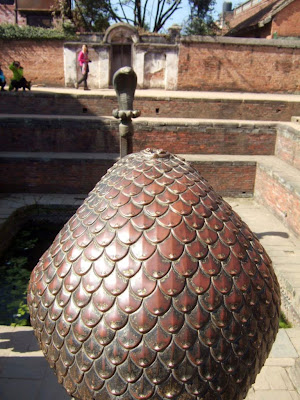
Palace of 55-windows, the unique and most fascinated structure in Bhaktapur Durbar Square was built in year 1427 during the reign of King Yaksha Malla and subsequently remodeled by King Bhupatindra Malla in 17th century. The setting and sculptured design of its 55 balcony windows among the brick walls are a master piece of woodcarving art. The Palace was home to royalty until 1769 and now a national art gallery and museum for its rich collection of medieval arts especially its fresco scroll.


The Golden Gate (Sundhoka) that links up the two blocks of actual palace buildings was a small entrance portal that access to Kumari Chowk and Taleju Mandir temple complex. The richly molded specimen gate is the most beautiful gilded copper work in Kathmandu Valley. Figures of door keeper and vase that symbolized good fortune are found at both sides of the gate. On top of the door is an image of ten-armed Goddess Telaju flanked by Shri and Lakshmi on a crocodile and tortoise. Appeared on the gates are also images of Hindu Gods Bhairava, Bhagawati, Ganesh, Kumari, Kali and other mythical creatures. It was erected in year 1753 by King Raja Ranjit Malla. The piece of old wood log behind the gate served as a parking stand for guests' riders in the past.



There are many of such kind of these intricately carved ancient doors inside the palace.




Taleju Temple that dedicated to Goddess Taleju Bhawain inside the Palace is very rich in ornamentation.



The marvelous piece of carving art with guardian deities looking down from their sanctuaries above the door at Taleju Temple.



Elaborately carved roof struts at Taleju Temple


Each roof strut was beautifully carved with images of various guardian deities in different posture and design.



Awesome!




Taleju Temple at Mul Chowk are shrines to both Taleju and Kumari Goddess.



The main and oldest courtyard Mul Chowk that dedicated to Goddess Taleju at the Palace central was built in year 1324. It could be accessed from a carved wooden entrance gate from a winding path around Bhairava Chowk. The six courtyards that survived from its original 99 also include Kumari Chowk. .


Nagh Pokari also known as Snake Pond was the royal bathing tank built in early 16th century.


Looking over the royal bathing tank were two gilt Naga figure, standing high up from the water facing each other.




The gilt copper writhing animal figurines at the sprout of the water tank was remarkable.


Professional or non-professional, who care? They shared the same sight.



The happy Nepalese students.


No comments:
Post a Comment